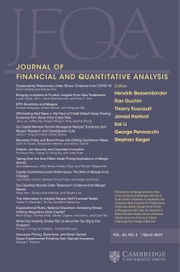No CrossRef data available.
Article contents
When Spotlights Fade: Local Newspaper Closures and Financial Advisor Misconduct
Published online by Cambridge University Press: 26 June 2025
Abstract
Using individual records of about 950,000 financial advisors, we find that the probability and intensity of financial advisor misconduct significantly increase after local newspaper closures. The impact is more pronounced in counties with a higher proportion of seniors, minorities, and individuals with lower education levels. Male advisors are more likely to commit misconduct following newspaper closures than female advisors. The sensitivity of advisors’ job turnover to misconduct decreases after closures, suggesting a lower cost of committing misconduct. Our evidence indicates that local newspapers play a distinct role in mitigating financial advisor misconduct, as media exposure raises the costs of misbehavior.
Information
- Type
- Research Article
- Information
- Creative Commons
- This is an Open Access article, distributed under the terms of the Creative Commons Attribution-NonCommercial-ShareAlike licence (http://creativecommons.org/licenses/by-nc-sa/4.0), which permits non-commercial re-use, distribution, and reproduction in any medium, provided the same Creative Commons licence is used to distribute the re-used or adapted article and the original article is properly cited. The written permission of Cambridge University Press must be obtained prior to any commercial use.
- Copyright
- © The Author(s), 2025. Published by Cambridge University Press on behalf of the Michael G. Foster School of Business, University of Washington
Footnotes
We thank an anonymous referee, Ran Duchin (the editor), Barry Hettler, Robert Larson, Natalia Mintchik, Stella Park, Jeremy Schwartz, Drew Sellers, Michael Tang, Yogesh Uppal, Peter Woodlock, Ian Zhang, and Ronghuo Zheng and conference and workshop participants at the 2023 All Ohio Accounting Academic Conference, the 2023 AAA Diversity Section Meeting, the 2024 University of Hawai’i Accounting Research Conference, the 2024 AAA FARS Midyear Meeting, the 2024 AAA MAS Midyear Meeting, Kent State University, Youngstown State University, and the University of Dayton for helpful comments and suggestions. The authors assume responsibility for any remaining errors. Zhang acknowledges the financial support of the Ambassador Crawford College of Business and Entrepreneurship.

